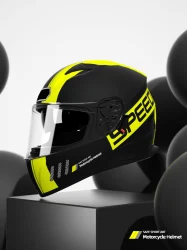The Evolution of Motorcycle Helmets: From Leather Caps to Modern Marvels
2024-09-14
Motorcycle helmets have come a long way from their humble beginnings as simple leather caps. Over the decades, advancements in technology, materials, and design have transformed helmets into highly engineered safety devices. In this blog post, we’ll take a look at the fascinating evolution of motorcycle helmets and how they’ve changed the way we ride.
The Early Days: Leather Caps and Minimal Protection
In the early 1900s, when motorcycles were becoming popular, helmets were not even a standard accessory. Riders often wore leather caps, which offered little more than protection from the wind and sun. There was little concern about head injuries, as speeds were relatively low and the risks weren’t fully understood.
However, as motorcycles became faster and more powerful, the need for head protection became more apparent. It wasn't until 1935, after the tragic death of British Army officer T.E. Lawrence (better known as Lawrence of Arabia), that the importance of helmets gained attention. The doctor who treated him highlighted the risks of head injuries, and soon after, the first rudimentary helmets began to appear.
1950s-1960s: The Birth of Modern Helmet Design
The 1950s and 60s saw a major shift in helmet design with the introduction of the first full-coverage helmets made of fiberglass. These helmets were far superior to their leather predecessors, offering protection for the entire head, including the face and jaw. In 1953, a professor named C.F. Lombard created the first helmet designed specifically to absorb impact, which became the blueprint for modern designs.
By the late 1960s, helmet use became more widespread, and governments around the world began to introduce helmet laws to protect riders. During this time, the first helmet safety standards, such as the DOT certification in the U.S., were established, ensuring that helmets met specific safety criteria.
1980s-2000s: Advanced Materials and Technologies
With the introduction of materials like polycarbonate and advanced fiberglass composites, helmets became lighter and stronger during the 1980s. Innovations in padding and lining materials also improved comfort and fit, making helmets more user-friendly for long-distance riders.
The 1990s saw further advancements, with the introduction of modular helmets, which combined the protection of full-face helmets with the convenience of an open-face design. This period also saw a rise in helmets with integrated visors, ventilation systems, and communication devices, adding extra functionality to the basic helmet design.
Today: High-Tech Helmets for the Modern Rider
In recent years, helmets have become highly sophisticated, incorporating cutting-edge technology for maximum safety and comfort. Today’s helmets are often made from advanced materials like carbon fiber, which provides unparalleled strength while remaining lightweight.
One of the biggest innovations in modern helmet design is the inclusion of smart technology. Helmets with built-in Bluetooth communication systems, rearview cameras, and heads-up displays are becoming increasingly common. Some even feature MIPS (Multi-directional Impact Protection System), which helps reduce rotational forces during an accident, providing even greater protection.
Conclusion
From simple leather caps to high-tech safety gear, the evolution of motorcycle helmets is a testament to the importance of rider safety. As technology continues to advance, we can expect helmets to become even more protective, comfortable, and functional. Whether you’re a weekend rider or a seasoned biker, the modern helmet is an essential piece of gear that offers much more than just head protection—it’s a crucial tool that enhances your entire riding experience.



